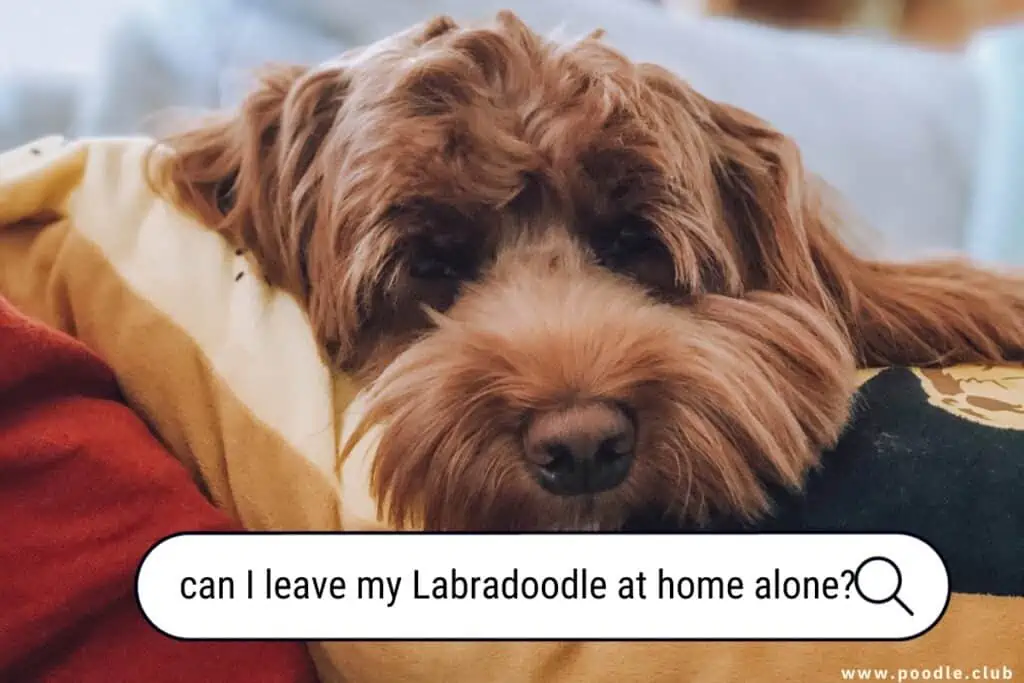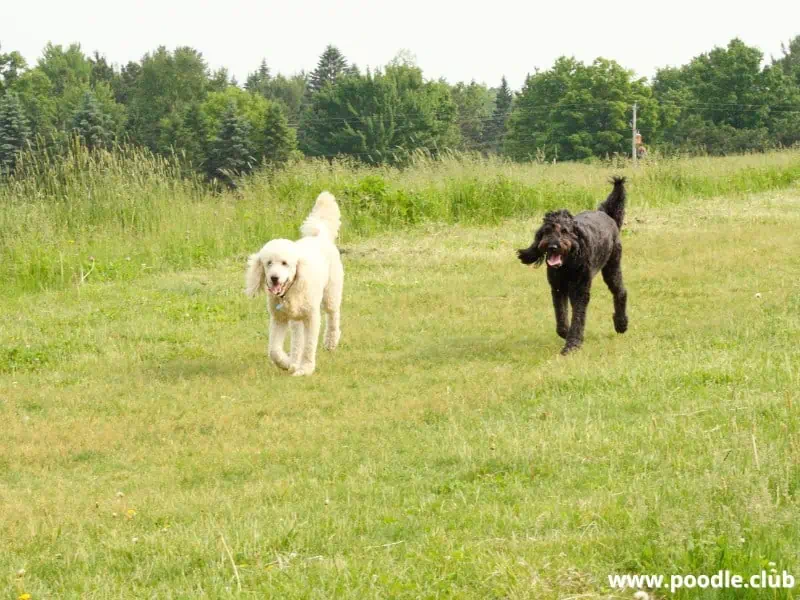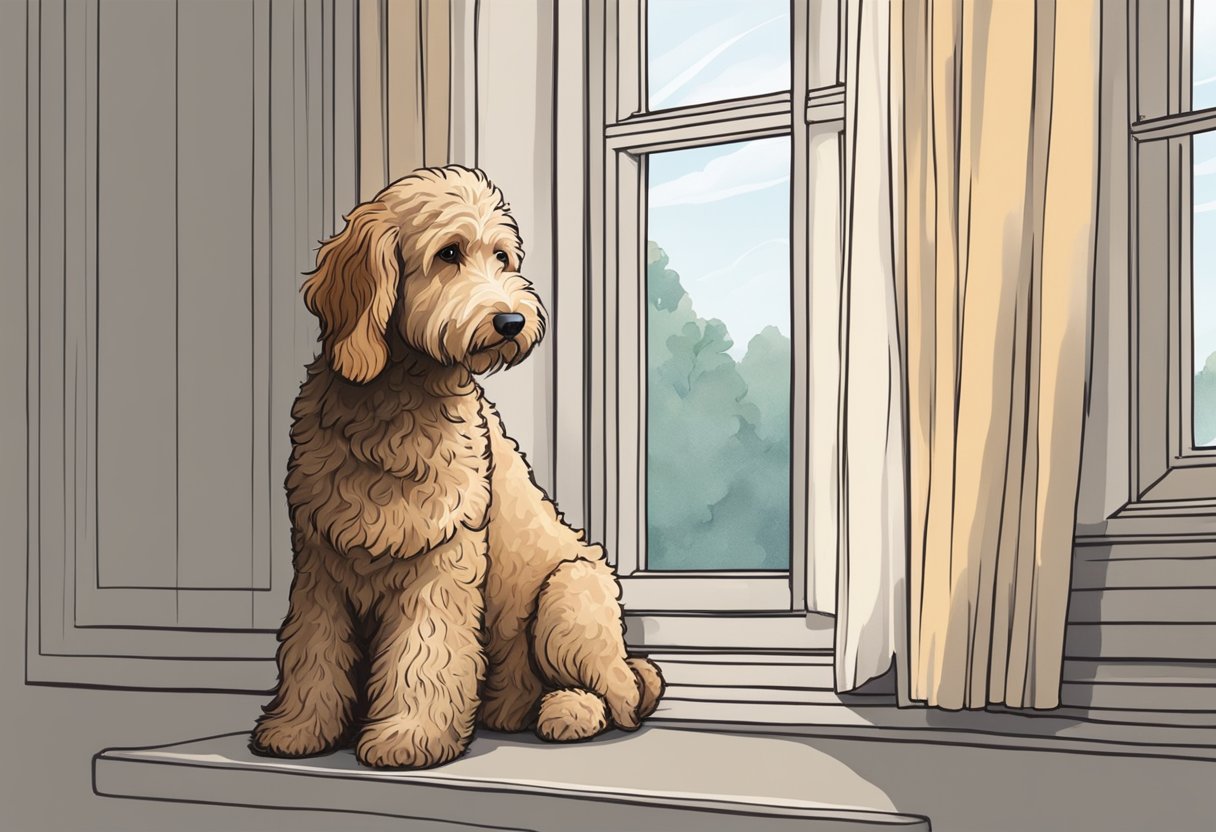Can I Leave My Labradoodle at Home Alone? Essential Tips and Guidelines
As a Labradoodle owner, you may find yourself wondering if it’s okay to leave your furry friend at home alone for extended periods. This breed is known for its intelligence, friendly nature, and good temperament, which could make them an excellent potential candidate for staying home.
However, there are a few factors to consider before deciding how long it’s appropriate to leave your Labradoodle alone.
Understanding the needs of your Labradoodle is crucial in determining whether or not they can be left unsupervised for a certain amount of time.
Factors such as their age, individual temperament, and companionship needs play a significant role. Furthermore, taking measures to manage separation anxiety, providing a safe and comfortable environment, and keeping your pet occupied during your absence can ensure their well-being.

Key Takeaways
- Consider your Labradoodle’s age, temperament, and companionship needs when deciding how long they can be home alone.
- Mitigate separation anxiety with proper training and establishing routines.
- Provide a comfortable environment and engaging activities to keep your Labradoodle occupied in your absence.
Understanding Labradoodles
Labradoodles are a popular breed of dog, created by crossing a Poodle with a Labrador Retriever. As a result, you’ll find that they inherit characteristics from both parent breeds, leading to a unique temperament and appearance.

Being a Labradoodle owner, you need to understand their temperament to better assess if they can be left home alone. They are friendly, energetic, and sociable dogs, known for their intelligence and eagerness to please. Although Labradoodles are generally adaptable, it’s essential to keep in mind that their exercise and mental stimulation needs require your attention.
To understand your Labradoodle’s specific temperament, consider the influence of both parent breeds. Poodles are known for being intelligent, loyal, and easy to train, while Labrador Retrievers are gentle, friendly, and outgoing. It is crucial to acknowledge that individual Labradoodles might lean more towards one of the parent breeds’ temperaments, so pay close attention to your dog’s unique personality.
Keep in mind the potential for separation anxiety in your Labradoodle, as both Poodles and Labrador Retrievers can develop anxiety when separated from their owners for extended periods. To help prevent or mitigate this issue, gradually increase the time you leave your Labradoodle alone, ensuring that they have a comfortable space with toys and distractions.
Caring for your Labradoodle involves meeting their exercise and grooming needs. A daily walk and playtime will help them burn off energy and stay mentally stimulated. As for grooming, Labradoodles may have either a curly Poodle-like coat or a wavy Labrador-like coat, meaning the grooming requirements might differ for each dog.
Regular brushing or visits to a professional groomer are recommended to keep their coat healthy and tangle-free.
Ultimately, understanding your Labradoodle’s temperament, exercise needs, and grooming requirements will help you make an informed decision about whether or not you can leave them home alone.
Age and Companionship Needs
As a Labradoodle owner, it’s important to consider the age and companionship needs of your dog when deciding whether or not to leave them at home alone for extended periods. Dogs at different life stages have varying needs.
PuppySpot is a reputable dog marketplace where you can browse and find compatible puppies right from the comfort of your home. They have placed over 200,000 puppies into homes in the US!

Puppies, especially, should not be left alone for too long, as they require more frequent potty breaks, feeding, socialization, and supervision. Puppies need lots of attention to help them develop good behaviors and ensure they become well-adjusted, confident adult dogs.
Adult dogs generally have a more solid routine and can be left alone for longer periods, with some exceptions. Adult Labradoodles are usually more adaptable to spending time alone, but every dog is unique. Make sure you gradually increase the time spent alone and ensure your dog is comfortable at each interval before proceeding.
As social animals, they need interaction and stimulation to stay happy and healthy.
In the case of older dogs, their needs may also vary. Some older Labradoodles might need special attention due to health issues or age-related changes in their behavior. Others might be able to handle being alone for a few hours, as long as they have access to their food, water, and a comfortable place to rest.
Keep in mind that Labradoodles are highly social animals and thrive on your companionship. Regardless of age, they don’t like being alone for extended periods. Always ensure that their emotional and physical needs are met while you’re away.
Maintain a consistent and stimulating environment to keep them satisfied. If you find that you need to leave your Labradoodle alone for longer than they can comfortably manage, consider hiring a dog sitter or enrolling them in doggy daycare.
Managing Separation Anxiety
Leaving your Labradoodle at home alone can result in separation anxiety, which can manifest in various anxiety-based behaviors. It’s essential to learn how to manage these issues to ensure your pet feels safe and comfortable while you’re away.

If you notice signs of anxiety in your Labradoodle, such as trembling, whining, or pacing, it’s crucial to address the problem before it becomes a serious issue. Uncontrolled bowels may also be a sign of severe anxiety.
One effective method to minimize separation anxiety is using a pet calming diffuser. These devices release a calming pheromone that helps to alleviate your dog’s stress while you’re away.
It’s also essential to establish a consistent routine for your Labradoodle. This helps your dog understand when you leave and when you’re expected to be back home. Gradually increasing the duration of time spent alone can also help your pet in adapting to your absence.
Make sure to provide your Labradoodle with engaging toys and distractions to keep their mind occupied while you’re gone. This can help to prevent anxiety from building up in your absence.
Remember that managing separation anxiety in your Labradoodle requires patience and consistency. By taking the proper steps, you can help to ensure a positive home environment for your pet, even when you’re not there.
Creating a Safe and Comfortable Environment
Before leaving your Labradoodle home alone, it’s crucial to prepare a space that ensures both safety and comfort. Start by selecting a designated area for your dog, either indoors or outdoors, and think about using a crate if your dog is crate-trained and feels secure in it.

Ensure that your Labradoodle has enough room to roam and stretch comfortably. Clear out any potential hazards such as electrical cords, and make sure the furniture is durable and unlikely to be damaged by your dog. Setting up a safe space like this will create a familiar and comfortable environment for your pet while you’re away.
When preparing the outdoor space, provide a sheltered area for your Labradoodle to relax while also offering sufficient room for movement and play. Ensure that the outdoor area is securely fenced, eliminating any chance of escape.
Remember to remove any harmful plants or chemicals from the setup, as these can pose danger to your Labradoodle’s health. Additionally, ensure your pet has access to fresh water and appropriate food if needed. Providing stimulating toys and interactive puzzles can also alleviate boredom and stress during your absence.
Ultimately, a secure and comfortable environment will help ease your Labradoodle’s anxiety while you’re away. By incorporating these guidelines into your setup, you can confidently leave your pet home alone with peace of mind.
Keeping Your Labradoodle Occupied
While you’re at work, it’s essential to keep your Labradoodle busy and entertained to avoid boredom and potential destructive behavior. Here are some ideas to help you keep your furry friend occupied:

First, ensure that your Labradoodle gets its daily exercise before you leave for work. A tired dog is a happy dog. You can take your dog for a walk or spend some quality time playing fetch in the backyard.
This activity will leave them panting, enhancing the chances of them resting while you’re away.
To keep your Labradoodle entertained with food, consider providing puzzle toys filled with treats or snacks. These toys stimulate your dog’s mind and satisfy their natural urge to forage. The challenge of figuring out how to access the treats will keep your dog busy for an extended period.
Incorporating more toys into your dog’s day can provide endless fun and entertainment. Rotate your Labradoodle’s toys regularly to maintain their interest. Offer different types of toys, like chew toys, plush toys, and squeaky toys to cater to their various preferences.
Dogs enjoy having background noise while home alone. Leaving a radio on low volume may help your Labradoodle feel more at ease, as the sound creates an ambient noise that can soothe them during your absence.
Schedule activities with a pet sitter, family member, or friend if your Labradoodle requires more companionship. They can drop by during the day to take your Labradoodle for a walk or play a game of fetch, giving them the interaction they crave.
Remember, providing a variety of entertainment options for your Labradoodle will prevent boredom and ensure they’re happy and content while home alone. By addressing their physical, mental, and emotional needs, you’ll return to a calm and satisfied pet.
Getting Outside Help
If you must leave your Labradoodle home alone for an extended period, consider seeking help from other sources. A dog walker can visit your home regularly, ensuring that your dog gets exercise and companionship throughout the day. Hiring a reputable company is essential to ensure the safety of your pet.

Another option is reaching out to a neighbor or family member that may be willing to help with your dog’s care. They can take turns visiting your dog, playing with them, feeding them, and taking them for walks. Create a checklist for them to follow, so they know your dog’s routine and preferences.
If you cannot find someone to help with individual visits, look into doggy daycare facilities. These offer supervised care and socialization for dogs during the day. Research the available options in your area and choose the one that best suits your Labradoodle’s needs.
Lastly, consult with your vet to ensure the well-being of your Labradoodle while you’re away. They can offer guidance and recommendations to prevent any health or behavioral issues that may arise from being home alone.





![Dog Gums Are BLACK [Is This Normal?]](https://poodle.club/wp-content/uploads/2022/04/dogs-gums-are-black-768x512.webp)
